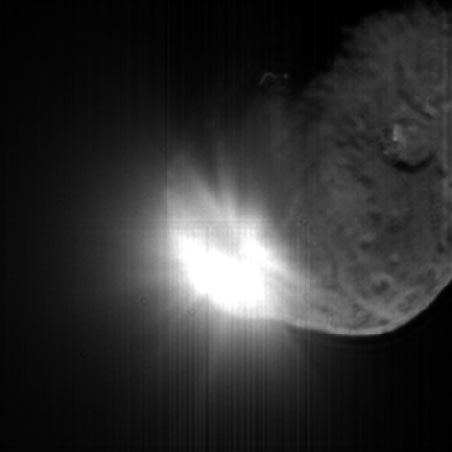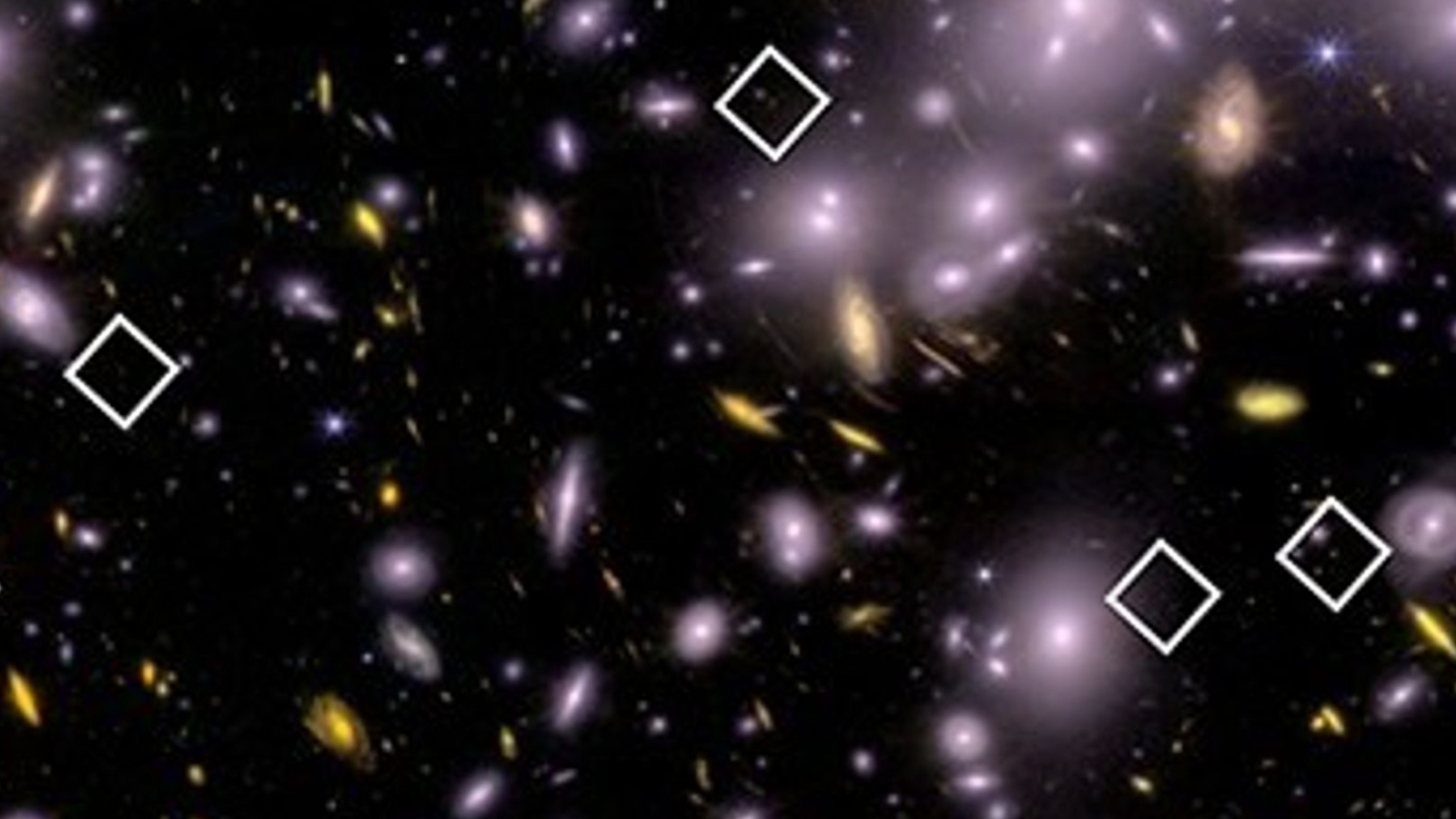Afterglow: NASA Lauds Deep Impact's Comet Crash

PASADENA -- Deep Impact scientists andengineers are lauding their mission's successful collision with Comet Tempel 1and are already drawing some conclusions about the icy wanderer.
Based on images taken by DeepImpact's Flyby mothership, which tracked the mission's collision with Tempel 1,astronomers believe the comet's surface was covered in a soft material.
"This was probably a soft surface, adusty surface," explained said Deep Impact co-investigator Peter Schultz duringa press conference today at NASA's Jet Propulsion Laboratory (JPL). "I've madea living playing in a sandbox, and now I can say I've played with a comet."
The press conference - the secondmission update today - was preceded by the song Rock Around the Clock by BillHailey and the Comets. The surviving members of the Comets will perform tomorrow for the Deep Impact team as part of a mission's success celebration.

Researchers were able to presentadditional images of the 820-pound (371-kilogram) Impactor probe's collisionwith Tempel 1, which occurred at 1:52 a.m. EDT (0552 GMT) on July 4.
"We sawsome pretty spectacular things happen at impact," Jessica Sunshine, a co-investigator on the Deep Impact team's spectrometer instrument, told SPACE.com. "It got reallyhot, then we saw it cool down and we saw significant amounts of materials comeout, we're still trying to understand exactly what."
Michael A'Hearn, Deep Impact'sprincipal investigator at the University of Maryland,told reporters that the next task is pinning down Impactor's crater.
Breaking space news, the latest updates on rocket launches, skywatching events and more!
"It's clear that the ejecta wasstill coming out, at least after the [impact] event," A'Hearn said. "Ifthere're a lot of volatiles there, the outgassing would continue."
Mission scientists are eager to collect allthe data from Flyby, but do not currently have plans for an extended mission.
"Once we get all the data downand finish the look back, we'll consider a mothballing procedure," saidRick Grammier, Deep Impact project manager at JPL.
A hot collision
Theincrease in heat happened very quickly during Impactor's collision, whichresearchers expected based on test models, Sunshine said.

"What wedidn't know, and we still don't know was how long did the increase last? Whatmaterials were ejected? How quickly does it cool down? We're still trying toplow through that," she added.
Deep Impact researchers andengineers had set up a pool over the possible effects of Impactor's collision.While it is still unknown how large the resulting crater is, some researchershave ventured to make their own estimates.
"I don't think it'shouse-sized, I think it's bigger than that," Schultz said. "I'm sure the[impact temperature] is going to be in the thousands of degrees Kelvin, you getthat when your slamming objects together like this."
The averagerange of temperature of the comet is between 240 and 300 Kelvins,which is consistent with a body as far from the Sun as Tempel 1, researcherssaid.
"Thethermal map we showed today was fairly far out," Sunshine said. "We have a mapof before and after with much greater detail. We have the nucleus at sevenmeters, its closest approach, so we will really be able to tie that informationwith some of the visible morphology and try to understand how the comet retainsheat, which is an important issue for how it outgases."
Meanwhile,still only about 10 percent of the data collected from impact has beentransmitted.
"It'sfrustrating for us," Sunshine said with a smile. "The spectrometer is a datahog. It takes the longest to come down. I will take about four days before itall comes down."
Even so,the best is yet to come, Sunshine said. The time series showing the Impactorheading towards the comet is only the tip of the iceberg. "The movie is goingto get better."
Just like the simulations
The Deep Impact scienceteam is elated given the success of the Impactor.

"We are all besideourselves," said Lucy McFadden, Deep Impact science team co-investigator at theUniversity of Maryland, inan interview. "We did everything we were supposed to do when we plan an experiment."
McFadden told SPACE.com that lab experiments werecarried out by researchers, as were computersimulations - all to make the team's scientific hypotheses about what might beseen when the Impactor collided with Tempel 1.
"We planned ourexperiment and conducted it. All along we tried not to be too sure ofourselves. So with humility, we thought that something entirely different wouldactually happen," McFadden said. "But guess what...it happened almost as one ofour models predicted.
The model that literallyhit the mark, McFadden said, was the one where the comet is very porous andgravitationally bound. The Impactor produced a dramatic ejecta curtain that wasbound to the comet, she added.
"We are ecstatic, andvery tired. I think I'll have a smile on my face for many months,"McFadden said.
Peopleshouldn't be worried about the impact, Sunshine said.
"This isnothing new to the comet," she said. "Every body in the solar system has hadimpacts on it, including ours. Comets are no different. What we're trying tounderstand is how does it react to this controlledexperiment."
The teamwas fortunate that Tempel 1 experienced naturally occurring outbursts in theweeks prior to the collision.
"We werelucky enough to capture some natural outbursts and now we can try to compare thosewith what we saw at impact in terms of material that came out and how deep wethink this crater went," Sunshine said.
SPACE.com Senior Space WriterLeonard David contributed to this story from Boulder, Colorado.
- Deep Impact: Viewer's Guide and Mission News
Join our Space Forums to keep talking space on the latest missions, night sky and more! And if you have a news tip, correction or comment, let us know at: community@space.com.

Tariq is the Editor-in-Chief of Space.com and joined the team in 2001, first as an intern and staff writer, and later as an editor. He covers human spaceflight, exploration and space science, as well as skywatching and entertainment. He became Space.com's Managing Editor in 2009 and Editor-in-Chief in 2019. Before joining Space.com, Tariq was a staff reporter for The Los Angeles Times covering education and city beats in La Habra, Fullerton and Huntington Beach. In October 2022, Tariq received the Harry Kolcum Award for excellence in space reporting from the National Space Club Florida Committee. He is also an Eagle Scout (yes, he has the Space Exploration merit badge) and went to Space Camp four times as a kid and a fifth time as an adult. He has journalism degrees from the University of Southern California and New York University. You can find Tariq at Space.com and as the co-host to the This Week In Space podcast with space historian Rod Pyle on the TWiT network. To see his latest project, you can follow Tariq on Twitter @tariqjmalik.
